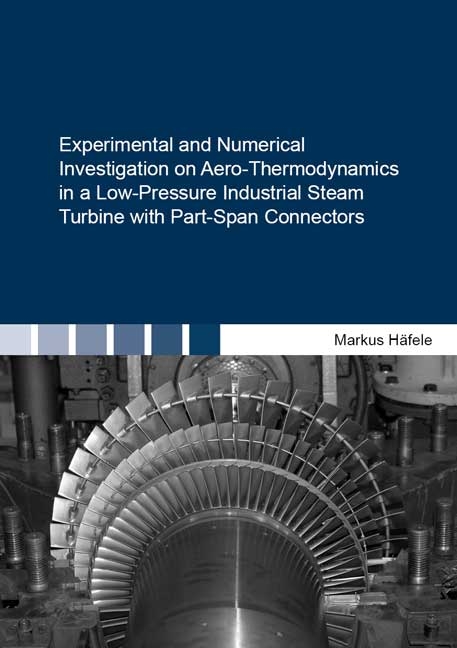Experimental and Numerical Investigation on Aero-Thermodynamics in a Low-Pressure Industrial Steam Turbine with Part-Span Connectors
Seiten
Industrial steam turbines are designed for flexible, reliable and robust operation with the ability for short start-up times. Basically assigned to the power class up to 250 MW, this type of turbine is normally operated over an extremely wide range of speed, loading and backpressure. In order to ensure safe turbine operation, even in blade resonance condition, part-span connectors (PSC) are mounted between adjacent blades. However, additional losses are generated, affecting the turbine performance.
The main focus of the present work is put on the loss due to PSCs in low-pressure (LP) steam turbine blading. Turbine test rig measurements under real steam conditions and three-dimensional computational fluid dynamics (CFD) utilizing a non-equilibrium steam model are conducted. Both reveal strongly pronounced aero-thermodynamic effects of the PSCs on the wet steam flow, whereby the PSC in the last stage LP blading results in a reduction of stage efficiency by almost 4% at the best efficiency point. Based on the acquired experimental data, the developed CFD models are validated successfully over a wide range of operating conditions. Overall, the applied models are suitable for an industrial design process. Within a PSC parameter study, a performance assessment of PSC designs is presented. Moving a cylindrical PSC down to mid-span and further lowering its diameter provides the largest leverage in terms of efficiency gain. Additional benefits can be achieved by switching to a more streamlined shape. The PSC study is complemented by a validation of analytical loss correlations widely used in industry. Overall, a good agreement is found between the correlations and CFD. In conclusion, using the present results a substantial improvement of turbine efficiency can be achieved.
The main focus of the present work is put on the loss due to PSCs in low-pressure (LP) steam turbine blading. Turbine test rig measurements under real steam conditions and three-dimensional computational fluid dynamics (CFD) utilizing a non-equilibrium steam model are conducted. Both reveal strongly pronounced aero-thermodynamic effects of the PSCs on the wet steam flow, whereby the PSC in the last stage LP blading results in a reduction of stage efficiency by almost 4% at the best efficiency point. Based on the acquired experimental data, the developed CFD models are validated successfully over a wide range of operating conditions. Overall, the applied models are suitable for an industrial design process. Within a PSC parameter study, a performance assessment of PSC designs is presented. Moving a cylindrical PSC down to mid-span and further lowering its diameter provides the largest leverage in terms of efficiency gain. Additional benefits can be achieved by switching to a more streamlined shape. The PSC study is complemented by a validation of analytical loss correlations widely used in industry. Overall, a good agreement is found between the correlations and CFD. In conclusion, using the present results a substantial improvement of turbine efficiency can be achieved.
| Erscheinungsdatum | 03.12.2020 |
|---|---|
| Reihe/Serie | Berichte aus der Strömungstechnik |
| Verlagsort | Düren |
| Sprache | englisch |
| Maße | 148 x 210 mm |
| Gewicht | 363 g |
| Themenwelt | Naturwissenschaften ► Physik / Astronomie ► Strömungsmechanik |
| Technik ► Maschinenbau | |
| Schlagworte | CFD • Efficiency • Loss Correlations • LP Steam Turbine • Measurement • PSC |
| ISBN-10 | 3-8440-7697-2 / 3844076972 |
| ISBN-13 | 978-3-8440-7697-4 / 9783844076974 |
| Zustand | Neuware |
| Haben Sie eine Frage zum Produkt? |
Mehr entdecken
aus dem Bereich
aus dem Bereich
Buch | Hardcover (2022)
Springer Vieweg (Verlag)
CHF 689,95




